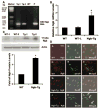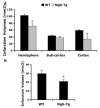Effects of neuroglobin overexpression on acute brain injury and long-term outcomes after focal cerebral ischemia
- PMID: 18403737
- PMCID: PMC2727360
- DOI: 10.1161/STROKEAHA.107.506022
Effects of neuroglobin overexpression on acute brain injury and long-term outcomes after focal cerebral ischemia
Abstract
Background and purpose: Emerging data suggest that neuroglobin (Ngb) may protect against hypoxic/ischemic neuronal insults. However, the underlying mechanisms in vivo and implications for long-term outcomes are still not well understood.
Methods: Using our newly created Ngb overexpressing transgenic (Ngb-Tg) mice, we measured brain infarction on day 1 and day 14 after transient focal cerebral ischemia and performed neurobehavioral assessments in sensorimotor deficits on days 1, 3, 7, and 14. To test the hypothesis that Ngb may play a role in reducing oxidative stress after stroke, intracellular malondialdehyde levels were measured and compared in Ngb-Tg and wild-type mice.
Results: Increased Ngb mRNA and protein levels were identified in Ngb-Tg brains. Malondialdehyde levels in ischemic hemispheres of Ngb-Tg were significantly reduced compared with wild-type controls at 8 hours and 22 hours after transient focal cerebral ischemia. Compared with wild-type controls, brain infarction volumes 1 day and 14 days after transient focal cerebral ischemia were significantly reduced in Ngb-Tg mice. However, there were no significant improvements in sensorimotor deficits for up to 14 days after stroke in Ngb-Tg mice compared with wild-type controls.
Conclusions: Ngb reduces tissue infarction and markers of oxidative stress after stroke. Tissue protection by overexpressing Ngb can be sustained for up to 2 weeks.
Conflict of interest statement
Figures



Comment in
-
Neuroglobin: endogenous neuroprotectant or maintenance of homeostasis?Stroke. 2008 Nov;39(11):e177-8; author reply e179. doi: 10.1161/STROKEAHA.108.526533. Epub 2008 Sep 18. Stroke. 2008. PMID: 18802204 No abstract available.
References
-
- Awenius C, Hankeln T, Burmester T. Neuroglobins from the zebrafish Danio rerio and the pufferfish Tetraodon nigroviridis. Biochem Biophys Res Commun. 2001;287:418–421. - PubMed
-
- Zhang CG, Li L, Deng MY, Xie F, Wang CL, Zhou WQ, Wang HY, He FC. Coding region cDNA sequence cloning of rat neuroglobin gene, its polymorphism feature and tissue expression profile analysis [in Chinese] Yi Chuan Xue Bao. 2001;28:997–1001. - PubMed
-
- Burmester T, Weich B, Reinhardt S, Hankeln T. A vertebrate globin expressed in the brain. Nature. 2000;407:520–523. - PubMed
-
- Burmester T, Hankeln T. Neuroglobin: a respiratory protein of the nervous system. News Physiol Sci. 2004;19:110–113. - PubMed
-
- Garry DJ, Mammen PP. Neuroprotection and the role of neuroglobin. Lancet. 2003;362:342–343. - PubMed
Publication types
MeSH terms
Substances
Grants and funding
LinkOut - more resources
Full Text Sources
Other Literature Sources
Miscellaneous

